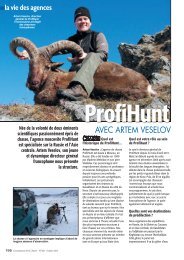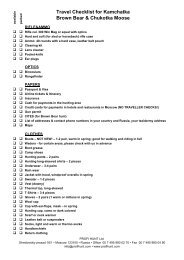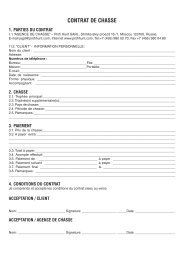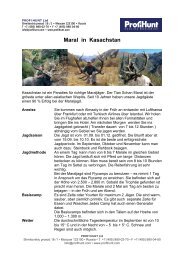Create successful ePaper yourself
Turn your PDF publications into a flip-book with our unique Google optimized e-Paper software.
Gobi Argali<br />
Ovis Ammon Darwini<br />
Gobi Argali is a magnificent sheep that inhabits Mongolian Mountains. The specie was always of<br />
great interest for the hunters, and the trip itself was always among the most popular.<br />
The average size of Gobi Argali horns is 41-46 inches with the base diameter of 14-16 inches. In<br />
2007 our client Gary Hansen took the New World Record trophy of Gobi Argali. The measurements<br />
totaled 226 3/8” points SCI.<br />
Gobi Argali is more abundant in number compared to the other Mongolia’s Argali. During the year,<br />
structure of herds changes, with most adult males leaving groups of females early in the spring and<br />
migrating either higher in elevation or from south to north slopes. Seasonal migrations have been<br />
reported for some populations (especially the males), while there is a general trend to live at higher<br />
elevations in the summertime.<br />
General Characteristics. Gobi Argali is lighter in color and smaller in body size compared to Altai<br />
and Hangay Argali. As Altai Argali, Gobi Argali hasn’t a whitish neck ruff. Females are slightly lighter<br />
in color than males. During summer, males and females have a short, usually brown, pepperand-salt–colored<br />
coat. Summer pelage has more reddish tones, and a distinct black-brown stripe<br />
appears in the middle of the back and neck. Young Argali are a light gray-yellow color with a darker<br />
gray-brown head. Coat of young begins to darken at 5–6 months, and pelage characteristic of<br />
adult males has developed by 6 years. Cross section of horn is rounder shape in contrast to Pamir<br />
Argali’s cross section that triangular-shaped base with sharp angled edges.<br />
Distribution. This Argali is found all across the Gobi region that occupies almost a third of Mongolia’s<br />
large territory and north of China.<br />
How to get there. Your way to Ulaanbaatar (UB) lies via Frankfurt, Moscow or Seoul. Our representative<br />
meets you upon arrival to UB and assists through the customs. Then we take you to the hotel.<br />
Next morning you are transferred to the hunting camp in the southern part of Mongolia; transfer<br />
takes about 10 hours. Take your iPod, it can help you to fill in the time during this tiresome drive.<br />
Hunting season. July 20 to September 30.<br />
Hunting. While observing Argali feeding and resting areas, you get your Gobi Argali by spot and<br />
stalk. The most preferable hunting time is in the morning or in the evening, but be prepared to<br />
spend the whole day in the hunting area. We use jeeps for the transportation in the area.<br />
Duration of the trip: 14 days trip, 10 days hunt.<br />
Additional trophies: Gobi Ibex.<br />
Base camps. The camps are traditional Asian yurts. They are warm, clean and comfortable with<br />
separate areas for dining, bathing and sleeping. Electricity is supplied by generating sets. Every<br />
camp has a cook and an interpreter. You will find very good food and quality service.<br />
Equipment. Daypack, rain gear, knife with stop (pocket size), binoculars 10-12x, spotting scope 60x<br />
& tripod of medium size, rangefinder, flashlight, sunglasses, waterproof jacket, mountain boots,<br />
thermal top, light sleeping bag.<br />
Possible combinations. Altai Argali, Hangay Argali, Altai Ibex, Gobi Ibex, White-tailed Gazelle,<br />
Black-tailed Gazelle, Roe Deer, Wild Boar, Wolf, Mongolia.<br />
Vadim Gomzyakov (Russia)<br />
George Harms (USA)<br />
Sergey Lyapuntsov (Russia)








